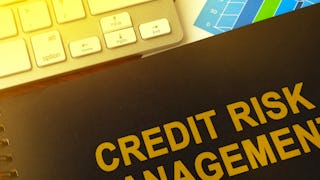This course provides the foundation for understanding the frameworks used to develop market risk management strategies. You will identify the market risks associated with each type of financial instrument. You will be introduced to techniques for estimating the risk associated with each class of investments. By the end of the course, you will be able to select the most effective derivatives for managing risk of a single asset and a portfolio of assets, develop asset selection strategies for managing risk in a portfolio, and model risk associated with a single asset and a portfolio of assets.



Market Risk Management: Frameworks & Strategies
This course is part of Risk Management Specialization

Instructor: Jack Farmer
11,798 already enrolled
Included with 
(165 reviews)
Recommended experience
What you'll learn
Identify best-practice frameworks for assessing market risk.
Estimate Value at Risk and use in a risk management strategy.
Model market factors such as interest rates, equity, and commodity prices.
Skills you'll gain
Details to know

Add to your LinkedIn profile
12 assignments
See how employees at top companies are mastering in-demand skills

Build your subject-matter expertise
- Learn new concepts from industry experts
- Gain a foundational understanding of a subject or tool
- Develop job-relevant skills with hands-on projects
- Earn a shareable career certificate


Earn a career certificate
Add this credential to your LinkedIn profile, resume, or CV
Share it on social media and in your performance review

There are 6 modules in this course
This course provides the foundation for understanding the frameworks used to develop market risk management strategies. You will identify the market risks associated with each type of financial instrument. You will be introduced to techniques for estimating the risk associated with each class of investments. By the end of the course, you will be able to select the most effective derivatives for managing risk of a single asset and a portfolio of assets, develop asset selection strategies for managing risk in a portfolio, and model risk associated with a single asset and a portfolio of assets.
What's included
1 video4 readings1 discussion prompt1 plugin
In module one we’ll look at the different types of financial instruments that are the source of market risk. We'll first look at bonds and then at equities and lastly, we’ll explore derivatives.
What's included
4 videos1 reading4 assignments
Now that we've had a complete look at different financial instruments and derivatives take a look at measuring and analyzing market risk first from the perspective of probabilistic measures and then second from the perspective of statistical measures.
What's included
3 videos1 reading3 assignments
Now you have a good understanding of the risks that are inherent in different types of financial instruments and also of the derivatives that you can use to hedge those risks. You also are familiar with different methods for measuring and analyzing each type of market risk. Now we will look at how risk managers model and manage market risk.
What's included
4 videos1 reading4 assignments
What's included
3 videos1 reading1 assignment
What's included
1 video1 reading1 plugin
Instructor

Offered by
Explore more from Finance


Rice University


University of Geneva


Kennesaw State University


New York Institute of Finance
Why people choose Coursera for their career




Learner reviews
165 reviews
- 5 stars
74.54%
- 4 stars
16.96%
- 3 stars
6.66%
- 2 stars
1.21%
- 1 star
0.60%
Showing 3 of 165
Reviewed on Jan 5, 2022
Very good course to understand the different ways of measuring and managing Market risk.
Reviewed on Dec 22, 2021
Awesome course!! This will look good on the resume and help secure a better job for me.
Reviewed on Mar 29, 2025
Excellent. Instructor knows their stuff. Great for those who are working in the Financial Industry and for those who dabble in investments.
New to Finance? Start here.

Open new doors with Coursera Plus
Unlimited access to 10,000+ world-class courses, hands-on projects, and job-ready certificate programs - all included in your subscription
Advance your career with an online degree
Earn a degree from world-class universities - 100% online
Join over 3,400 global companies that choose Coursera for Business
Upskill your employees to excel in the digital economy
Frequently asked questions
Access to lectures and assignments depends on your type of enrollment. If you take a course in audit mode, you will be able to see most course materials for free. To access graded assignments and to earn a Certificate, you will need to purchase the Certificate experience, during or after your audit. If you don't see the audit option:
The course may not offer an audit option. You can try a Free Trial instead, or apply for Financial Aid.
The course may offer 'Full Course, No Certificate' instead. This option lets you see all course materials, submit required assessments, and get a final grade. This also means that you will not be able to purchase a Certificate experience.
When you enroll in the course, you get access to all of the courses in the Specialization, and you earn a certificate when you complete the work. Your electronic Certificate will be added to your Accomplishments page - from there, you can print your Certificate or add it to your LinkedIn profile. If you only want to read and view the course content, you can audit the course for free.
If you subscribed, you get a 7-day free trial during which you can cancel at no penalty. After that, we don’t give refunds, but you can cancel your subscription at any time. See our full refund policy.
More questions
Financial aid available,

